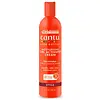What's inside
What's inside
 Benefits
Benefits

 Concerns
Concerns

 Ingredients Side-by-side
Ingredients Side-by-side

Water
Skin ConditioningGlycerin
HumectantPropanediol
SolventCetearyl Alcohol
EmollientButyrospermum Parkii Butter
Skin ConditioningParfum
MaskingStearyl Alcohol
EmollientCetyl Alcohol
EmollientPolyquaternium-10
Cocos Nucifera Oil
MaskingBiotin
AntiseborrhoeicFolic Acid
Skin ConditioningNiacin
SmoothingPantothenic Acid
Skin ConditioningCyanocobalamin
Skin ConditioningPyridoxine Hcl
Skin ConditioningRiboflavin
Cosmetic ColorantThiamine Hcl
MaskingSimmondsia Chinensis Seed Oil
EmollientOlea Europaea Fruit Oil
MaskingArgania Spinosa Kernel Oil
EmollientDaucus Carota Sativa Seed Oil
EmollientMacadamia Ternifolia Seed Oil
EmollientMangifera Indica Seed Butter
Skin ConditioningPrunus Amygdalus Dulcis Oil
Skin ConditioningVitis Vinifera Seed Oil
EmollientAloe Barbadensis Leaf Juice
Skin ConditioningLonicera Caprifolium Flower Extract
PerfumingMacrocystis Pyrifera Extract
Skin ConditioningSalvia Officinalis Leaf Extract
CleansingUrtica Dioica Leaf Extract
Skin ConditioningHydrolyzed Silk
HumectantPersea Gratissima Oil
Skin ConditioningBehentrimonium Methosulfate
Phenoxyethanol
PreservativePolysorbate 60
EmulsifyingPolyquaternium-11
Benzyl Benzoate
AntimicrobialPolyquaternium-39
Cetrimonium Chloride
AntimicrobialEthylhexylglycerin
Skin ConditioningCoumarin
PerfumingSilk Amino Acids
HumectantHexyl Cinnamal
PerfumingLeuconostoc/Radish Root Ferment Filtrate
AntimicrobialBenzyl Salicylate
PerfumingBenzyl Alcohol
PerfumingPotassium Sorbate
PreservativeSodium Benzoate
MaskingCitric Acid
BufferingSodium Sulfite
PreservativeWater, Glycerin, Propanediol, Cetearyl Alcohol, Butyrospermum Parkii Butter, Parfum, Stearyl Alcohol, Cetyl Alcohol, Polyquaternium-10, Cocos Nucifera Oil, Biotin, Folic Acid, Niacin, Pantothenic Acid, Cyanocobalamin, Pyridoxine Hcl, Riboflavin, Thiamine Hcl, Simmondsia Chinensis Seed Oil, Olea Europaea Fruit Oil, Argania Spinosa Kernel Oil, Daucus Carota Sativa Seed Oil, Macadamia Ternifolia Seed Oil, Mangifera Indica Seed Butter, Prunus Amygdalus Dulcis Oil, Vitis Vinifera Seed Oil, Aloe Barbadensis Leaf Juice, Lonicera Caprifolium Flower Extract, Macrocystis Pyrifera Extract, Salvia Officinalis Leaf Extract, Urtica Dioica Leaf Extract, Hydrolyzed Silk, Persea Gratissima Oil, Behentrimonium Methosulfate, Phenoxyethanol, Polysorbate 60, Polyquaternium-11, Benzyl Benzoate, Polyquaternium-39, Cetrimonium Chloride, Ethylhexylglycerin, Coumarin, Silk Amino Acids, Hexyl Cinnamal, Leuconostoc/Radish Root Ferment Filtrate, Benzyl Salicylate, Benzyl Alcohol, Potassium Sorbate, Sodium Benzoate, Citric Acid, Sodium Sulfite
Ingredients Explained
These ingredients are found in both products.
Ingredients higher up in an ingredient list are typically present in a larger amount.
Aloe Barbadensis Leaf Juice comes from leaves of the aloe plant. Aloe Barbadensis Leaf Juice is best known for helping to soothe sunburns. It is also anti-inflammatory, moisturizing, antiseptic, and can help heal wounds.
Aloe is packed with good stuff including Vitamins A, C, and E. These vitamins are antioxidants, which help fight free-radicals and the damage they may cause. Free-radicals are molecules that may damage your skin cells, such as pollution.
Aloe Barbadensis Leaf Juice also contains sugars. These sugars come in the form of monosaccharides and polysaccharides, folic acid, and choline. These sugars are able to help bind moisture to skin.
It also contains minerals such as calcium, 12 anthraquinones, fatty acids, amino acids, and Vitamin B12.
Learn more about Aloe Barbadensis Leaf JuiceEthylhexylglycerin (we can't pronounce this either) is commonly used as a preservative and skin softener. It is derived from glyceryl.
You might see Ethylhexylglycerin often paired with other preservatives such as phenoxyethanol. Ethylhexylglycerin has been found to increase the effectiveness of these other preservatives.
Glycerin is already naturally found in your skin. It helps moisturize and protect your skin.
A study from 2016 found glycerin to be more effective as a humectant than AHAs and hyaluronic acid.
As a humectant, it helps the skin stay hydrated by pulling moisture to your skin. The low molecular weight of glycerin allows it to pull moisture into the deeper layers of your skin.
Hydrated skin improves your skin barrier; Your skin barrier helps protect against irritants and bacteria.
Glycerin has also been found to have antimicrobial and antiviral properties. Due to these properties, glycerin is often used in wound and burn treatments.
In cosmetics, glycerin is usually derived from plants such as soybean or palm. However, it can also be sourced from animals, such as tallow or animal fat.
This ingredient is organic, colorless, odorless, and non-toxic.
Glycerin is the name for this ingredient in American English. British English uses Glycerol/Glycerine.
Learn more about GlycerinPhenoxyethanol is a preservative that has germicide, antimicrobial, and aromatic properties. Studies show that phenoxyethanol can prevent microbial growth. By itself, it has a scent that is similar to that of a rose.
It's often used in formulations along with Caprylyl Glycol to preserve the shelf life of products.